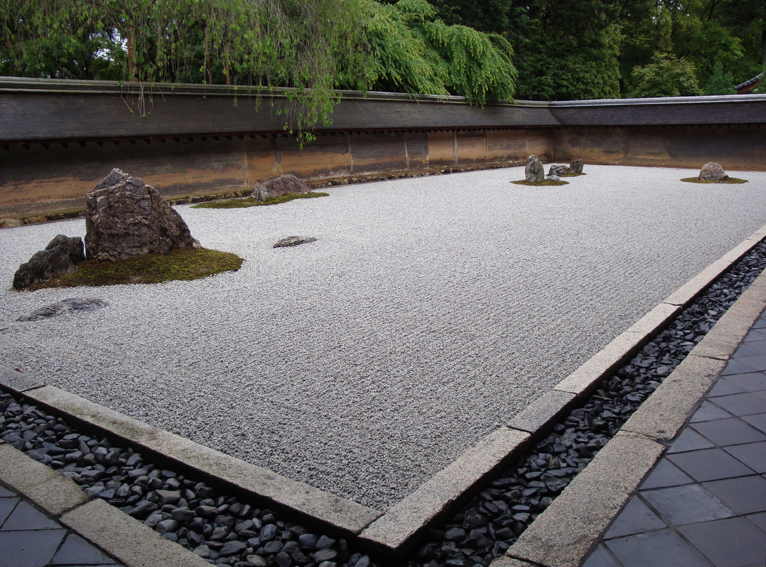April 12, 2004


Ryoan-ji Temple's dry rock garden is a puzzle. Nobody knows who designed it or what the meaning is of the 15 rocks scattered across its expanse of raked white gravel. Some academics say they. 時刻表 周辺地図(Googleマップ) (マーカーは正確な停留所の位置を示すものではありません。) この停留所のバス接近情報 【せ】で始まる停留所. Ryoanji: Solos for Oboe, Flute, Contrabass, Voice, Trombone With Percussion or Orchestral Obbligato (1983–85) John Cage. John Cage John Cage (1912–1992) created works in several different media—music, performance, writing, and visual art—throughout his lifetime. Temple complex Ryōanji, Kyoto, Japan, 15th century, the present dry garden design is thought to date back at least to the early 1680s Speakers: Dr. Ryōanji is a temple located in north Kyoto, Japan affiliated with a branch of Zen Buddhism. The followers of Zen Buddhism pursued “enlightenment” or “awakening” by means of self-introspection and personal experience in daily life. The quintessence and aesthetics of Zen is epitomized in the rock garden and architecture of Ryōanji.

by Yusuke Shimizu

History
In 1450, feudal lord Hosokawa Katsumoto built Ryoanji, a Zen Buddhist temple. Zen
philosophy emphasizes simplicity, so that we can appreciate simple colors like white or
black. Although the original buildings were burnt down in Japan’s civil wars, they were
rebuilt in 1799, after further damage from natural disasters.
The building pictured here is called a kuri (living quarters) and it is 75 feet high. A
building’s height represents the status of the temple. This is one of the highest buildings
among temples in Japan showing us that Ryoanji enjoys a high status.
Ryoanji Kyoto
Benten Island
There is a small island in the temple’s pond which is called Benten Island. The name
Benten is an abbreviation of Benzaiten, who is a goddess, one of the Seven Deities of
Good Fortune. She is believed to be the deity of wisdom, wealth, courage, eloquence and
music. When you see pictures or sculptures of the seven gods, you can easily find
Benzaiten since she holds a biwa, a four-stringed Japanese lute. It is said that your
wishes, especially related to music, will come true if you place a stone upon the pile on
the torii gate in Benten Island. The higher you place the stone, the better your luck will
be!
Rock Garden
Ryoanji Temple is very famous for its rock garden. This garden is in the style of a dry
landscape, which has neither water nor plants (except for moss) only rocks and raked
white sand. In this garden, 15 rocks are arranged in five groups on white sand. From
the east, groupings of 5, 2, 3, 2 and 3 stones are arranged. The reason why there are 15
stones is that in the Orient, this number represents perfection since it takes 15 days for
a new moon to become full. Moreover, nobody can see all of the rocks from any angle,
meaning that human beings lack perfection.
There are several theories about what this seemingly simple garden represents.
Some people imagine mountains rising above clouds. Others imagine islands in the sea.
One fascinating theory holds that each of the five groups of rocks has a particular
meaning: The easternmost group, beginning from the main hall of worship, represents
Buddha and means ‘perfection’. The next group, seen to its right, is a whale and means
‘biggest’. The center group is a tiger and means ‘strongest’. The next group is a turtle
and means ‘longevity’. And the last group is a water bird and means ‘almighty’, because
such birds can live both on land and water. Nevertheless, it’s up to you to decide what
the rocks at Ryoanji represent. Let your imagination run free! I’ve heard that someone
has said this rock garden represents people’s whole life. Can you see the point?
Tsukubai
A tsukubai is a stone basin set in a Japanese garden, in which we wash our hands
before taking part in a tea ceremony. The name tsukubai comes from our motion when
we bend down to ladle up the water.
Ryoanji Plan Drawings
There are four Chinese characters on the surface of the tsukubai, and in a special
device, each of the characters combines with the central square hole to form yet another
character. The top one becomes a character which means “I”. The left becomes “learn”,
the right now means “only”, and the bottom character changes into “to be content.
” Together, these four Chinese characters mean “I learn only to be content.” This suggests
that people should be satisfied with their present situation. It is one of the concepts of
Zen philosophy, emphasizing the importance of controlling our desires and knowing our
own mind.
A Hiding Place
Near the tsukubai is a pine tree which goes through the roof of a building. At first, there
was not such a tree. But after a tree grew up in the spot, the temple’s priests had to cut
a hole for it (rather than cutting the tree) because this temple is registered as a world
cultural heritage, where the natural features must not be disturbed. Ryoanji’s grounds
have many kinds of trees and moss, which display great natural beauty which always
impress visitors from overseas. The best season to visit this temple is autumn. If you
can, try not to miss the exciting fall colors before the leaves into a wintry landscape.
Ryoanji Tea House

